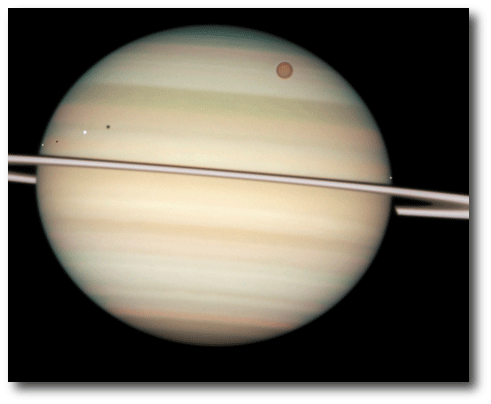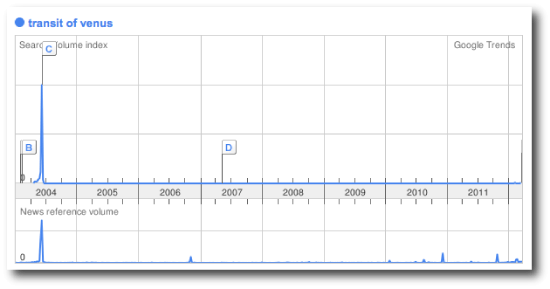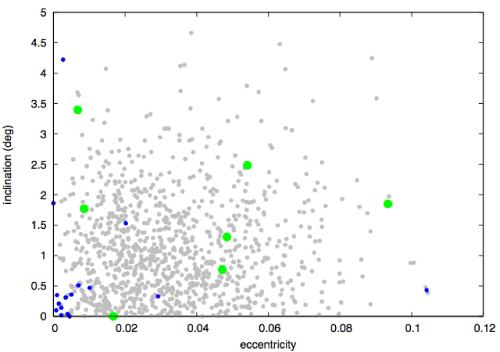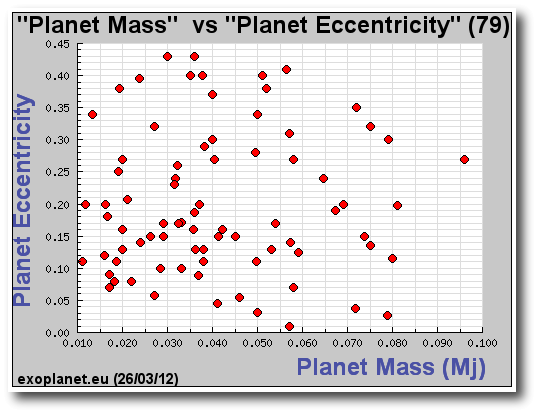
Enceladus, Dione, Titan, Mimas and Saturn.
On Tuesday, Venus reaches its maximum elongation of 46 degrees from the Sun. Thereafter, its angular separation from the Sun steadily decreases until June 6th, when it undergoes transit.

Transits of Venus are newsworthy because they are rare. Venus’ orbit is inclined by 3.4 degrees relative to the ecliptic, and so Earth must be near Venus’ nodal line if a transit is to be observed. The last one occurred in 2004, and the next one after June 6th will occur in December 2117. When talking transits-of-Venus in this day and age of astronomers flossing their “premium-platinum” frequent flyer status, it’s hard to resist that obligatory mention of Guillaume Le Gentil, whose unsuccessful expedition to observe the 1761 transit took 11 years, and had him returning to Paris in October 1771, only to find that he had been declared legally dead and been replaced in the Royal Academy of Sciences. His wife had remarried, and all his relatives had “enthusiastically plundered his estate.”
Nobody’s estate gets enthusiastically plundered on account of transits of the solar system’s Jovian planets by the solar system’s Jovian satellites. Many of the larger moons of Jupiter, Saturn and Uranus orbit with very small inclinations to the host-planet equatorial planes. As a result, it’s possible to get pictures such as the splash image for this post, with a whopping 4 moons transiting at once, without having to wait around for centuries.
Loosely speaking, eccentricities and inclinations are dynamical bruises acquired during the formation process. When the assembly of a system occurs in a quiescent, dissipative setting, then orbits wind up closer to circular and closer to co-planar. Violent interactions in the absence of dissipation produce systems that are more distended. To get a feeling for this, I gave a 3D-normal distribution of random impulsive kicks with standard deviation 0.003*v_circ to an aggregate of initially co-planar and circular orbits. The resulting distribution of inclinations and eccentricities, plotted as a locus of gray points, is reminiscent of the bulk of the Jovian satellites (blue points):

Cranking up the magnitude of the impulsive kicks by a factor of ten yields a distribution of eccentricities and inclinations that looks better suited to the actual planets in our solar system (green points). Note that Mercury and Iapetus fall outside the diagram.

The big surprise from the Kepler mission has been the large number of systems that display multiple transiting planets. Kepler sees plenty of set-ups that contain four, five, and even six individually transiting planets. This distribution is startling, however, only if one draws on the solar system as the template for expectations. Had the preconceived notions been drawn from the regular satellite systems of the Jovian planets, then the statistics would seem completely unsurprising.
A recent preprint by Figueira et al. describes a consistency analysis between the results of the HARPS and Kepler surveys. They find that the two distributions can be reconciled (and the large number of multiple-transiting planet systems accounted for) if planet-planet mutual inclinations are generally less than one degree.
This implies that the eccentricity measurements that have been published to date for low-mass planets are likely to contain a substantial number of overestimated e‘s…


I conclude that tidal dissipation has led to the large numbers of co-planar/ circular systems prevalent in the Kepler data – hence transiting planets? Since most of the stars in our Galaxy (from memory) @70% are Red Dwarfs (presumably the Kepler sample reflects this distribution). These systems are generally more compact, therefore if my logic is correct – stronger tidal effects and a resulting distribution of inclinations and eccentricities similar to the Jovian satellites?
The Figueira results are interesting. Similar calculations that look at Kepler results only (but consider all the higher multiplicities) are my work in http://arxiv.org/abs/1102.0543 and some additional analyses by Dan Fabrycky in http://arxiv.org/abs/1202.6328. We had a much finer grid in inclinations and also addressed a range of possible multiplicities, so I feel the work is complimentary. I’m working on a future paper along these same lines as well and hope to someday incorporate HARPS results (though without necessarily assuming that they are ground truth like Figueira did).
The plot from exoplanet.eu is in Jupiter masses, but recalling that 0.01 M_J = 3 M_Earth suggests that really only the left-most part of the plot corresponds to the Kepler sample of flat systems. Using the plotter at exoplanets.org adds error bars which brings most of these down to within 1-sigma of 0. A few exceptions are the planets in Gliese 581 (whose parameters are arguably in flux) and Gliese 667C, but one wonders whether additional planets, near-resonances, or other effects could be causing the eccentricity estimates to be off. Some systems that have short period super-Earths that truly appear to be eccentric include HD 181433b and GJ 876 d, but I would argue that these systems are not analogs to the Kepler systems that dominate the coplanarity estimate, which, as greg points out, look more like Gallilean satellites in their properties.
I’ll also note that the inclination distribution of the Kepler systems is actually similar to the solar system’s, but because the system is so much more compact, like the Gallileans, you get many more multi-transiting systems with high multiplicities.
@pete_j: tides rarely affect inclinations. I’ve run the numbers on tidal dissipation in Kepler systems and, unsurprisingly, the vast majority of them are completely unaffected by tides. We see compact systems around small stars with Kepler, but since we’re looking for Earth twins (and have a brightness limit), our sample is very dissimilar to a random (volume-limited) galactic sample; we have mostly G and K stars like the Sun.